
A cable-stayed bridge has one or more towers, from which cables support the bridge deck. A distinctive feature are the cables or stays, which run directly from the tower to the deck, normally forming a fan-like pattern or a series of parallel lines. This is in contrast to the modern suspension bridge, where the cables supporting the deck are suspended vertically from the main cable, anchored at both ends of the bridge and running between the towers. The cable-stayed bridge is optimal for spans longer than cantilever bridges and shorter than suspension bridges. This is the range within which cantilever bridges would rapidly grow heavier, and suspension bridge cabling would be more costly.

Britannia Bridge is a bridge in Wales that crosses the Menai Strait between the Isle of Anglesey and city of Bangor. It was originally designed and built by the noted railway engineer Robert Stephenson as a tubular bridge of wrought iron rectangular box-section spans for carrying rail traffic. Its importance was to form a critical link of the Chester and Holyhead Railway's route, enabling trains to directly travel between London and the port of Holyhead, thus facilitating a sea link to Dublin, Ireland.

An extradosed bridge employs a structure that combines the main elements of both a prestressed box girder bridge and a cable-stayed bridge. The name comes from the word extrados, the exterior or upper curve of an arch, and refers to how the "stay cables" on an extradosed bridge are not considered as such in the design, but are instead treated as external prestressing tendons deviating upward from the deck. In this concept, they remain part of the main bridge superstructure.

The Bandra–Worli Sea Link is a 5.6 km long, 8-lane wide cable-stayed bridge that links Bandra in the Western Suburbs of Mumbai with Worli in South Mumbai. It is the second longest sea bridge after Mumbai Trans Harbour Link, as well as the 5th longest bridge in India after Mumbai Trans Harbour Link, Bhupen Hazarika Setu, Dibang River Bridge and Mahatma Gandhi Setu. It contains pre-stressed concrete-steel viaducts on either side. It was planned as a part of the proposed Western Freeway that would link the Western Suburbs to Nariman Point in Mumbai's main business district, but is now planned to become part of the Coastal Road to Kandivali.

The Grand Duchess Charlotte Bridge is a road bridge in Luxembourg City, in southern Luxembourg. It carries the N51 across the Alzette, connecting Avenue John F. Kennedy, in Kirchberg, to Boulevard Robert Schuman, in Limpertsberg. The bridge is also known as the Red Bridge on account of its distinctive red paintwork. It is the main route connecting the city centre, Ville Haute, to Kirchberg, the site of the city's European Union institutions.

The Hares Hill Road Bridge is a single-span, wrought iron, bowstring-shaped lattice girder bridge. It was built in 1869 by Moseley Iron Bridge and Roof Company and is the only known surviving example of this kind. The bridge spans French Creek, a Pennsylvania Scenic River.

The Hulme Arch Bridge in Hulme, Manchester, England, supports Stretford Road as it passes over Princess Road, and is located at grid reference SJ838968. The construction of the bridge formed part of the regeneration of the Hulme district of Manchester, both by re-establishing the former route of Stretford Road, which had been cut into two halves by the construction of Princess Road in 1969, and by providing a local landmark. The location was previously occupied by a footbridge.
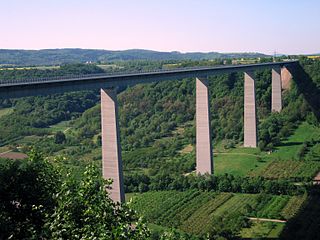
The Moselle Viaduct carries the Bundesautobahn 61 over a meander of the river Moselle, connecting the Hunsrück and Eifel mountain ranges. It was built between 1969 and 1972 between the German villages Winningen and Dieblich, about 10 kilometres (6.2 mi) southwest of Koblenz, where the river Moselle flows into the river Rhine.

The Bridge near Limyra is a late Roman bridge in Lycia, in modern south-west Turkey, and one of the oldest segmented arch bridges in the world. Located near the ancient city of Limyra, it is the largest civil engineering structure of antiquity in the region, spanning the Alakır Çayı river over a length of 360 m (1,181.1 ft) on 26 segmental arches. These arches, with a span-to-rise ratio of 5.3:1, give the bridge an unusually flat profile, and were unsurpassed as an architectural achievement until the late Middle Ages. Today, the structure is largely buried by river sediments and surrounded by greenhouses. Despite its unique features, the bridge remains relatively unknown, and only in the 1970s did researchers from the Istanbul branch of the German Archaeological Institute carry out field examinations on the site.
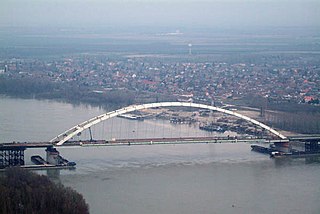
The Pentele Bridge or M8 Danube Bridge is a highway bridge spanning river Danube between Dunavecse and Dunaújváros. Construction was completed on 13 March 2007. The Pentele Bridge got her name after the village Dunapentele. The bridge is 1,682 m (5,518 ft) in length and 21 m (69 ft) wide, its main basket handle tied-arch span of 308 m (1,010 ft) ranks 60th among the longest arch bridge spans. It is part of the planned M8 motorway, connecting M6 motorway on the west and highway 51 on the east bank.

The Schierstein Bridge is 1,282-meter (4,206 ft) long, four-lane highway bridge in Germany. It carries Bundesautobahn 643 over the Rhine River between Mainz-Mombach, Rhineland-Palatinate and Wiesbaden-Schierstein, Hesse. Crossing two arms of the Rhine and the intervening island of Rettbergsaue, the bridge is made of six individual structures, including 100 m (330 ft) from prestressed concrete. It was built between 1959 and 1962.

The Sidu River Bridge is a 1,222 m-long (4,009 ft) suspension bridge crossing the valley of the Sidu River near Yesanguan in Badong County of the Hubei Province of the People's Republic of China. The bridge was designed by CCSHCC Second Highway Consultants Company, Limited. and built at a cost of 720 million yuan. It opened to traffic on November 15, 2009.
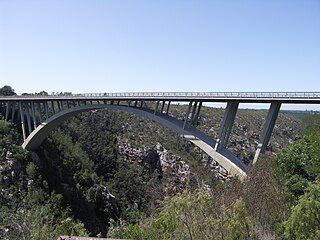
The Paul Sauer Bridge, also known as the Storms River Bridge, is a deck arch bridge over the Storms River in the Eastern Cape of South Africa. The bridge is located on the Garden Route section of National Route 2, between Cape Town and Port Elizabeth. At a maximum height of 120 metres (394 ft) above the Storms River, it was the highest concrete arch in Africa until the Bloukrans Bridge, 216 metres (709 ft), opened on the same road in 1984.

The Mirna Bridge is located between the Nova Vas and Višnjan interchanges of the A9 motorway in Istria, Croatia, spanning the Mirna River and the wide Mirna River valley. It is 1,378 metres (4,521 ft) long and comprises two traffic lanes. The bridge has been open for traffic since June 2005. The bridge is one of the most significant structures on the motorway. The bridge was designed by Zlatko Šavor.
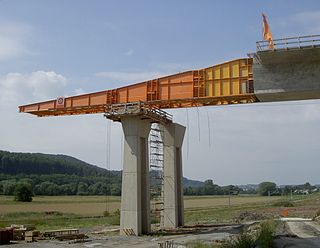
Incremental launch is a method in civil engineering of building a complete bridge deck from one abutment of the bridge only, manufacturing the superstructure of the bridge by sections to the other side. In current applications, the method is highly mechanised and uses pre-stressed concrete.

The Sant Boi Bridge is the first steel structure in the high-speed railway joining the city of Madrid and Barcelona.
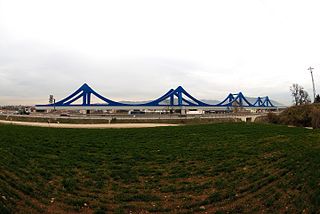
The Llinars Bridge this bridge is the first steel structure in the high-speed railway (HSR) joining Barcelona and the French Border. The 1,883-foot-long (574 m) Llinars HSR bridge comprises two parts: a 1,008-foot-long (307 m) composite steel–concrete structure crossing Autopista AP-7, and a continuous prestressed concrete bridge crossing the Mogent River with a maximum span of 157 feet (48 m).

The Worms Rhine Bridge is a two-track railway bridge that spans the Rhine river to the north of Worms, Germany, forming part of the Worms–Biblis railway.

The Germersheim Rhine Bridge is a two-track railway bridge that crosses the Rhine near Germersheim in the German state of Rhineland-Palatinate. It forms part of the Germersheim–Bruchsal railway.
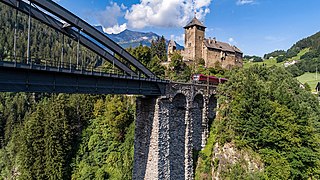
The Trisanna Bridge is a 211-metre long viaduct carrying the Arlberg railway over the Trisanna river just southwest of Pians, a district of Landeck (Tyrol) in Austria. The bridge spans the Paznaun valley and Trisanna gorge, forming part of one of the most important east-west railway routes in the Alps.





















